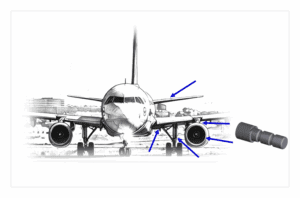Load Pin Advantage: Replacement of Existing Pins
Many of the research, testing, weighing and control applications that support the Aerospace, Industrial, Military, and Marine industries contain integrated force sensing capabilities. This sensing capability is typically designed to provide accurate measurement data throughout the entire development process, from providing force data used to validate a new design, through hardware build-up for additional component and system level testing, and finally to offer accurate force sensing for control of critical products, equipment and applications.
The previous go-to approach for embedding this capability was through the integration of standard off-the-shelf load cells. However, the standard load cell integration was not always clean and simple. Significant alterations could be required to the existing structure in service or under test to accommodate the load cells. These alterations at times would alter the item under test and typically add additional costs and time to the projects.
Another drawback, depending on where the load cell could fit, occurs when the load cell force measurement is not directly in line with the main load path of interest, and therefore further analysis can be required many times to determine the actual force.
Strainsert solved these problems with an innovative and creative approach to force measurement: the introduction of our patented Internally Gaged Load Pins. We developed standard Load Pins designed for easy fit and operation in common pin-joint hardware configurations, such as shackles, wire rope sockets, and hydraulic actuator joints.
Strainsert also specializes in the design and manufacture of custom Load Pins per specific customer requirements including mating hardware geometries, environment considerations, required measurement capacities, and factors of safety. The custom designed pins typically result in a custom drop-in sensor pin replacing the non-instrumented pin with minimal, if any, hardware modifications required.
Along with the simple installation, the load pins provide direct force measurement in the load path of interest, again not always the case when integrating other load cells. The load pins can replace almost any type of existing clevis pins, shear pins, or other types of pins used in existing structures to transfer load.
This innovation allows for real-time monitoring of loads and stresses on the pin joints, providing data and measurements that can be used for improving safety, efficiency, operation and predictive maintenance. Costly and time-consuming alterations or redesigns to the structure are also avoided, keeping the project on schedule and within budget.
Force sensing load pins can also be integrated into larger monitoring or control systems:
- Condition Monitoring Systems: Signals from multiple load pins can be fed into a central system that monitors the condition of machines or structures, alerting operators to overloads or potential failures.
- Safety Systems: In critical applications like cranes or lifting equipment, the load pin data can be used to trigger safety mechanisms. For example, if the load exceeds a certain threshold, the system might limit the operation of the equipment, trigger an alarm, or shut it down.
- Data Logging and Analysis: Data collected from load pins can be logged for long-term analysis. Historical load data is often used to improve maintenance, assess wear and tear, or optimize machine settings.
Brackets, alignment pins or other anti-rotation and retention methods can also be designed to provide easy installations without impacting surrounding support structures.
The internally gaged load pin is typically a double-shear arrangement, however, cantilever load pins with a single shear plane are available and provide the same advantages as double shear pins.
As an example, our custom load pins were integrated into the jet engine attachment joints, as well as the jet engine internal mechanical critical pin joints to determine interface and control forces. The custom load pins were also designed to measure engine cowling forces encountered during destructive testing. See the below sketch for pin location.

Other common applications where load pins play an important role include:
- Aerospace/Aircraft: Custom designed load pins provide feedback to guidance systems for control of engine thrust vectoring.
Load pins are integrated into the parachute restraint assembly to compare and monitor load distribution during chute deployment.
Load pins are used as a maintenance tool to determine if wing components are functioning within specific force parameters.
Load pins are also used in structural testing, landing gear joints and flap engagement forces
- Cranes and Lifting Equipment: Load pins can replace shear pins in lifting equipment and help monitor the weight being lifted, ensuring safe operation.
Hydraulic Systems: Used in hydraulic cylinders or load-bearing joints, load pins help monitor pressures in real-time. - Structural Monitoring: Force sensing load pins can be used in testing equipment or structural elements like bridges, buildings, or beams to track the load conditions.
- Marine and Offshore: Load management is critical in ship mooring, rigging, and other offshore operations.
If you have questions or want to discuss the feasibility of integrating a force sensing load pin into your current application, please contact us online or by phone at 1-610-825-3310

